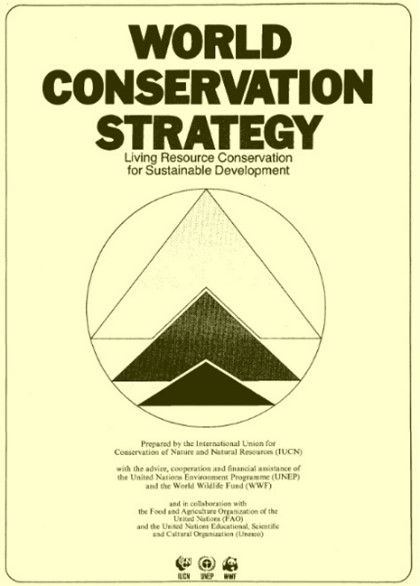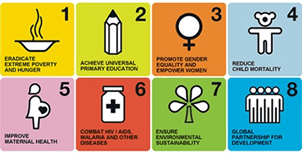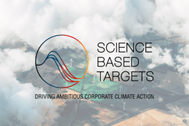By Claus Mølgaard (Note: Anja Juhl Jensen has updated the text fall 2022 with extra events)
Before 1900 there are very few policies established that concerns the environment. Religion has though historically had major influence on policies all over the World and in many of the different religious texts sustainability is mentioned in the form of eg that God gave the earth to his people and we should show respect for nature. Some mention of protection of scarce resources are also mentioned, but in the previous century more and more policies related to environment started appearing locally in different countries.
In the 1920ies, 1930ies and 1940ies protection of fauna and flora, plus restrictions on fishery, seals and wild animals started appearing. From 1950 to 1970 rules in regards to nuclear and oil pollution started appearing.
1972 – The United Nations Conference on Human Environment
From 1972 till today we have however seen a shift starting with The United Nations Conference on Human Environment – hosted in Stockholm in 1972 who acknowledged “Limits to growth” and emphasized the urgency to avert comprehensive ecological degradation (UN, 1973). The year is historic, because it is the first time countries across the World came together to identify and address environmental issues. After the conference, the UNEP – the United Nations Environmental Program – (link: https://www.unep.org/about-un-environment ) was established to monitor the process above and maintain consensus (Ivanov, 2018). The UNEP aimed at incorporating environmental concerns into economic goals and defined eco-development as follows:
“Development at regional and local levels, consistent with the potentials of the area involved, with attention given to the adequate and rational use of natural resources, technological styles and organizational forms that respect the natural ecosystems and local social and cultural patterns.” (UNEP, 1975)
In a way it was the beginning of the social and ethical dimension of the concept of sustainability.
The Worlds first major International Meeting on Climate Change
In 1979 the First World Climate Conference was held in Geneva, Switzerland. Mostly attended by scientists, this was the world’s first major international meeting on climate change. The attendees examined climate data, impact studies, climate topic identification, and research on climate variability and change.
The conference called upon the world’s governments “to foresee and prevent potential man-made changes in climate that might be adverse to the well-being of humanity”.
The two major outcomes of this conference were:
- The establishment of the World Climate Programme (WCP) (link til: https://public.wmo.int/en/programmes/world-climate-programme)
- The World Climate Research Programme (link https://www.wcrp-climate.org/about-wcrp/wcrp-overview)
Publishing of the report “World Conversation Strategy”
In 1980, the World Conservation Union, the UN and WWF published the report World Conversation Strategy, where the first lines of the foreword encountered the following text: “Human beings, in their quest for economic development and enjoyment of the riches of nature, must come to terms with the reality of resource limitation and the carrying capacities of ecosystem, and must take account of the needs of future generations”.

1983 – World Commission on Environment and Development
UN established 3 years later in 1983 the World Commission on Environment and Development. The commission was manned by 21 international celebrities and led by former Norwegian Prime Minister Gro Harlem Brundtland. The report Our Common Future, also known as the Brundtland Report, was published in 1987 and included the famous definition of sustainable development: “Sustainable development is development that meets the needs of the present without compromising the ability of future generations to meet their own needs.”
One of the major outcomes of the Brundtland report was the creation of the Intergovernmental Panel on Climate Change (IPCC)3 (link: https://www.ipcc.ch/about/)
1988 – Intergovernmental Panel on Climate Change
In November of 1990, the IPCC released their first assessment report which outlined that “emissions resulting from human activities are substantially increasing the atmospheric concentrations of greenhouse gases”.5 This report called for the need to take action and create a global climate change framework.
One month after the release of IPCC’s first report, the UN General Assembly established the Intergovernmental Negotiating Committee to create a climate change framework.
1992 – The Rio Earth Summit
Another major outcome of the Brundtland report was an international meeting, where more concrete initiatives and goals should be identified. It took a long time to organize the meeting, so first 5 years later in 1992 the Rio Conference was held, which ended up with the Agenda 21 report.
Agenda 21 is a 300 pages plan for achieving sustainable development in the 21st century. Among other things the following was stated:
• As many of the issues and solutions addressed in Agenda 21 have their roots in local activities, the participation and cooperation of local authorities should play an important role in achieving the goals.
• Each local authority should enter a dialogue with its citizens, local organizations and private companies and adopt a ‘local Agenda 21’.
• By 1996, most local authorities in each country should have initiated a consultative process with their peoples and agreed on a ‘local Agenda 21’ for local communities.
• The consultation process should increase each household’s awareness of sustainable development issues.
Agenda 21 was apparently not something that appealed to the general population.
At the Rio Earth Summit the United Nations Framework Convention on Climate Change (UNFCCC) (link: https://unfccc.int/about-us/about-the-secretariat ) was presented and adopted at the Rio Earth Summit in 1992. The framework was initially signed by 166 nations and grew to 196 countries by the time it came into full force in 1994.6
Although the UNFCCC did not contain specific targets to reduce greenhouse gas (GHG) emissions, it laid the foundation for subsequent climate change policies. UNFCCC annual meetings, the “Conference of the Parties” (COP), facilitates discussion and negotiation regarding the international community’s response to climate change.
1997 – The Kyoto Protocol
Following the establishment of the UNFCCC, the Kyoto Protocol was negotiated among nations and formally adopted in 1997. The Kyoto Protocol required developed countries to reduce GHG emissions by an average of approximately 5% below 1990 levels. This was the world’s first greenhouse gas emissions reduction treaty. 192 countries is signed up for the Kyoto Protocol and each year at the COPs, the Parties attempt to create additional agreements to help reduce emissions and hold each other accountable
2000 – The United Nations Millennium Goals
In 2000 the UN launched their 2015 goals, which are about eradicating of extreme poverty and hunger, achieving universal primary education, promoting gender equality and empower women, reducing child mortality, improving maternal health, combating HIV/AIDS, malaria, and other diseases, ensuring environmental sustainability, and developing a global partnership for development.

Most of the 8 goals showed progress from 2000 till 2015. (Link: https://www.un.org/millenniumgoals/2015_MDG_Report/pdf/MDG%202015%20rev%20(July%201).pdf)
2015 – United Nations Sustainability Development Goals
In 2015, the 8 UN 2015 goals should be renewed and were extended to the UN’s 17 goals or SDGs (Sustainable Development Goals) as we know them today. The SDGs are 17 concrete goals and a total number of 169 sub-goals with associated measurable indicators. The SDGs are signed by the leaders of all 193 UN member states. Pretty impressive that all countries agree to this.

The SDGs are an UN and countries matter. It is the members (countries) of UN that have committed each other to meet the goals by 2030. Many companies are also using the SDGs as inspiration for new businesses.
2015 – The Science Based Target initiative
The Science Based Target initiative was launched in 2015, as a partnership between CDP, UN Global Compact, World Resources Institute and WWF.

Science Based Target is based on the IPCC research of climate changes. Based on numbers of reports, the IPCC has statistically calculated the remaining carbon budget, which indicates how much CO2e we can emit into the atmosphere if the increase in temperature should be kept below 1.5°C, well below 2°C or below 2°C in 2100. Companies can choose whether they want to follow the 1.5°C pathway or the well below 2°C pathway (1.5°C recommended).
The CO2e reduction targets for a company who commit to Science Based Target are evaluated by the Science Based Target initiative. Once the company has had its goal approved, it is listed on the Science Based Target initiative’s website.
2015 – The Paris Agreement
In 2015, 196 countries adopted the Paris Agreement during the COP 21 meeting. The objective is to prevent the average global temperature from rising 2°C above pre-industrial levels, while aiming to remain below 1.5°C. Additionally, all Parties involved aspire to reach global net-zero GHG emissions by 2050. The only countries that have not formally approved the accord are Eritrea, Iran, Iraq, Libya, South Sudan, Turkey, and Yemen. USA also temporarily resigned under Trump, but re-joined again with Biden starting as president.
The next event planned is COP27 in the fall 2022 in Egypt